As an Amazon Associate I earn from qualifying purchases.
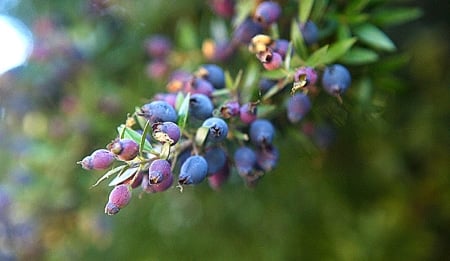
I’d never even heard of mirto until I read Efisio Harris’ Sweet Myrtle and Bitter Honey, which, to my mind, is the best English-language cookbook covering Sardinia — one of my favorite cuisines of Italy. Mirto is a heavy, sweet and herbal liqueur drunk all over Sardinia, at all occasions, much the way ouzo or raki is served in Greece.
With this description, I knew I had to have it. And I finally got my chance at the James Beard Awards in 2010, when I saw it on the menu at Craft, Chef Tom Colicchio’s flagship restaurant. When I took a sip, the liqueur tasted like a combination of gin and Fernet-Branca, another Italian digestif: Resinous, herbal, a little syrupy but very warming, very happy.
So what’s in mirto? Apparently, not much beyond myrtle berries and either honey or syrup. Huh. I can do that. It isn’t too different from my elderberry liqueur, only with myrtle berries. But how would I find this mystical plant?
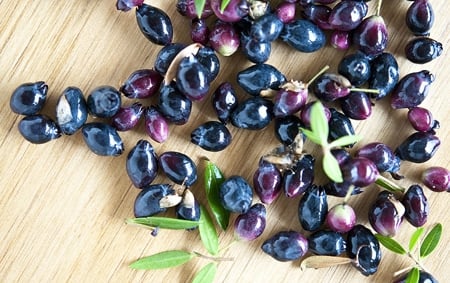
Myrtle is not the crape myrtle you may be thinking of. Myrtus Communis is “true” myrtle, and it is native to the Mediterranean. Mirto is made from its berries, and there is another drink called mirto bianco made from the flowers. Several years ago I tried to find myrtle — lots of Mediterranean recipes use myrtle’s aromatic leaves and twigs to flavor grilled meats — but had failed.
Apparently I didn’t look hard enough. No one at the nurseries I’d visited knew anything about a “myrtle bush” other than the crape myrtle. But when I thought to ask for Myrtus communis, they all said, “Oh yeah, we got that. It’s used for hedges.” Score! So I bought a bush. But by then the rains had stopped for the summer and, although I tried, my little myrtle bush died. Wah.
Then, one day, while I was at my friend Elise’s parent’s house, I noticed something. Something huge. “Holy shit! That’s a gigantic myrtle bush!” The myrtle bush alongside their house was 12 feet tall and easily 18 feet wide. And covered with blossoms. This bush wouldn’t die, and as I watched the blossoms turn into green berries, and the green berries turn into purple-black berries, I grew anxious.
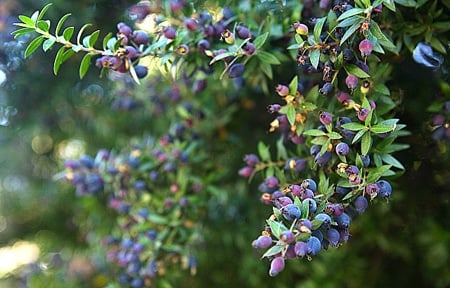
To make mirto, fill quart mason jars almost full with myrtle berries, then fill the jar with vodka — I like 100-proof because a) I am a well-known boozehound, and b) you get better extraction of an herb’s flavors with the higher alcohol content. Why not use Everclear? I suppose I could, but I’d like to drink this stuff eventually without going blind.
I’ll let my mirto steep for several months, then strain it and sweeten it with honey. It makes a wonderful after-dinner drink on cold winter nights.
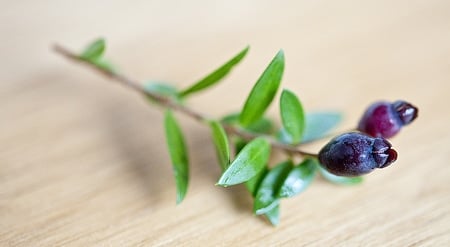
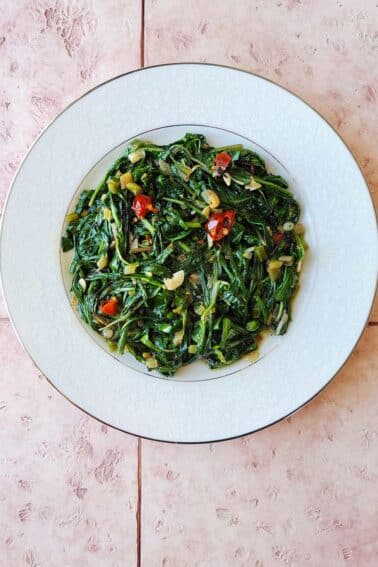
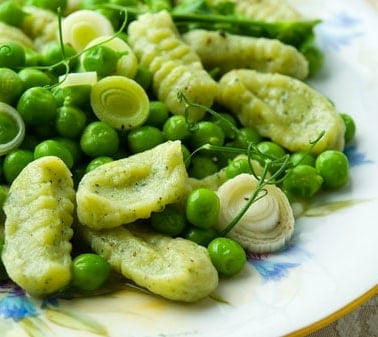

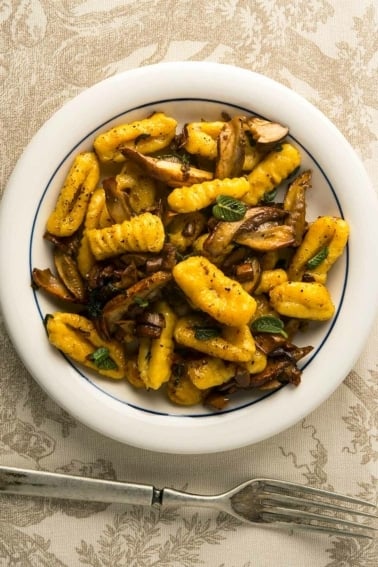
Has anyone tried this with Wax Myrtle (Myrica cerifera)?
In Melbourne Australia the Myrtle grows to about 5 meteres and the purple berries are huge. The flowers around Christmas time are white and the bees feast on the pollen. The tree is buzzing. Around April may the berries are ready to pick….you need t pick quick otherwise the pied currawong will eat them all. Not unusual to see 10 currawong eating the berries. If left alone within 3 days your berries are gone. easy to grow from seed and cuttings using high strength root grow hormone. Need lots of water to establish new plants otherwise they dry out and die. They also love being fertilised too
Traditionally, Mirto is flavored with rosemary and gentian root (available on Amazon, but use sparingly, as it’s quite bitter….on the order of grams per liter of liqueur to your taste) . It’s probably the type you had at Craft (Mirto Tremontis from Sardinia)
NotRichard: In addition to the myrtle berries? Thanks for the tip! Can you point me to somewhere I can read more about that?
Where does one find the berries in the USA?
John: Myrtus Communis is a common landscaping plant around here. Ask around at major garden stores.
When I make sloe gin or clove whiskey liqueur in the UK, I leave the berries or spices in 40% ABV (alcohol by volume) spirit for about 2 months – until the desired colour or flavour is reached. Pour through a sieve, let settle, and decant the clear spirit from any sediment if necessary. Then I add 115gm white sugar per 700ml bottle of clear spirit. Leave horizontally in a warm place and it will dissolve in 1-2 days. If you like syrupy sweet liqueurs, just use more sugar. I found that honey made it a little cloudy. This should work for all liqueurs, including myrtle.
Thanks for an interesting read Hank! I am from the island of Malta, south of Sicily. You convinced me to go find a fruiting myrtus communis and infuse the berries in alcohol and am waiting for the next ten weeks to pass! Can you please tell me a bit more about how to eventually sweeten it with honey? Many thanks, Leslie
We live in Puglia surrounded by myrtle bushes and I have annually made Mirto with great success using the supermarket alcohol. But a word of warning- I found if I mashed the berries the resulting flavour was very acrid and dried the mouth. That batch got thrown away!
My understanding was that it is important to use over 80 proof alcohols for liqueurs like limoncello (and presumably mirto) because if you don’t, it will freeze solid. It probably does extract better flavors, too, I would think.
Jeanette: I prefer 100 proof vodka, but it can be hard to find.
Nice to read the recipe for the Sardinian Mirto. It’s advisable to keep the bottle in the freezer and serve it cold. Regards.
Super impressed to see this in your archives. I used to live in Sardinia and the locals used every excuse to encourage us to acquire the taste for it. At the time I didn’t dig it. I’ll keep it in mind if I happen to see this elusive myrtle tree in the future.
I spent 6 years working for the Navy in La Maddalena located between Sardinia and Corsica – and came to love Mirto so much I startedmaking my own. To make the ‘white mirto’ we used the flowers and clean leaves. The first time most people taste it they don’t like it, often times I have heard ‘it tastes like robitussin.’ Myrtle grew wild on the islands so it as easy to get the berries. We always collected them in December. We also used the wood for smoking meats.
Now that I am living in southern California I would love to find some myrtle plants or trees – I will keep my eye out for them. I still have one bottle of 100% left…
Hi Hank!
Yet again, I google something and your name pops up! I typed in “hedge with blue berries and small leaves”, a photo appeared in google images which led me to your page. I was walking to meet my partner for lunch and noticed this hedge full of berries and figured by the looks of them, they must be edible. I was so happy to find your post on Mirto. I will be making a batch tonight. Thank you for all you do! Greetings from Santa Barbara!
PS: This foraging didn’t lead to any encounters with law enforcement, as the fennel seeds did.